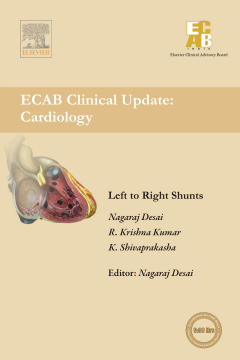
Additional Information
Book Details
Abstract
Patients born with cardiac defects need to be identified early and the severity of symptoms also needs to be identified. In children with larger defects or with more symptoms, early institution of treatment is warranted, since in absence of treatment, the disease progresses to pulmonary hypertension and a simple pathology gets complicated. Presence of congestive cardiac failure in infancy or of pulmonary artery hypertension is indication for early surgical treatment (prior to 6 months of age). Untreated ASD may at times allow the child to grow and reach adulthood, but can cause complications in adulthood also.
These issues related to understanding of natural history of the shunts and its implications in management decisions need to be addressed in clear terms. Also the role and timing of surgical therapy need to be emphasized. This book is designed to address such questions with supportive clinical scenarios. Thus, it provides an excellent opportunity to widen one’s perspective in this area.
Table of Contents
| Section Title | Page | Action | Price |
|---|---|---|---|
| Front Cover | Front Cover | ||
| Front Matter | ia | ||
| Elsevier Clinical Advisory Board:Cardiology | ic | ||
| Copyright | ie | ||
| About the Authors | if | ||
| Contents | ih | ||
| ECAB Clinical Update Information\r | i | ||
| Introduction | 1 | ||
| Natural History of Left to Right Shunts | 4a | ||
| Atrial Septal Defect | 5 | ||
| Spontaneous Closure | 7 | ||
| Pulmonary Hypertension and Pulmonary Vaso-Occlusive Disease | 7 | ||
| Heart Failure | 7 | ||
| Atrial Arrhythmias | 8 | ||
| Repaired ASD | 8 | ||
| Patent Foramen Ovale | 8 | ||
| Mortality | 9 | ||
| Atrioventricular Septal Defect | 9 | ||
| Natural History of Ventricular Septal Defect | 10 | ||
| Spontaneous Closure | 10 | ||
| Pulmonary Vascular Disease | 10 | ||
| Infective Endocarditis | 11 | ||
| Mortality | 11 | ||
| Aortic Regurgitation | 12 | ||
| Infundibular Pulmonary Stenosis | 12 | ||
| Patent Ductus Arteriosus | 13 | ||
| Spontaneous Closure | 13 | ||
| Congestive Heart Failure | 13 | ||
| Pulmonary Hypertension | 14 | ||
| Endarteritis | 14 | ||
| Aneurysm of Ductus Arteriosus | 15 | ||
| Mortality | 15 | ||
| Hemodynamic Assessment of Congenital Heart Defects with Left to Right Shunts and Pulmonary Hypertension | 20a | ||
| Introduction | 20 | ||
| Objectives of the Review | 24 | ||
| Correlating Pre-Operative Hemodynamics with Lung Biopsy Findings and Clinical Outcomes | 25 | ||
| Clinical and Non-Invasive Correlates of Hemodynamic Changes in Left to Right Shunts | 26 | ||
| Accurate Hemodynamic Assessment in Shunt Lesions: Who Needs it Most? | 26 | ||
| Role of Clinical Examination, Ecg, Chest X-ray, Echocardiography and Arterial Blood Gas | 28 | ||
| Hemodynamic Assessment in the Catheterization Laboratory | 30 | ||
| Correct Sequence of Sampling and Pressure Measurement | 32 | ||
| Calculation of Flows and Resistances | 33 | ||
| Common Sources of Error with Invasive Hemodynamic Assessment | 35 | ||
| Role of Reversibility Testing for Estimation of Operability | 36 | ||
| Conclusion | 40 | ||
| Surgery in Congenital Heart Disease with Left to Right Shunts | 45a | ||
| Introduction | 45 | ||
| Timing of Surgical Intervention: Broad Principles | 47 | ||
| Predicting the Natural History of Congenital Heart Disease | 48 | ||
| Precise Anatomic Diagnosis | 49 | ||
| Hemodynamic Assessment | 49 | ||
| Clinical Evaluation | 51 | ||
| Natural History Information | 51 | ||
| Spontaneous Closure of Defects | 52 | ||
| Procedural Outcome | 53 | ||
| Guidelines for Individual Lesions | 55 | ||
| The Effect of Co-morbidities | 58 | ||
| Surgical Operations for Left to Right Shunts | 58 | ||
| Pulmonary Artery Banding | 58 | ||
| Technique | 59 | ||
| Patent Ductus Arteriosus | 59 | ||
| Atrial Septal Defects | 60 | ||
| Partial Anomalous and Hemianomalous Pulmonary Venous Connections | 64 | ||
| Ventricular Septal Defects | 64 | ||
| Atrio-ventricular Canal | 65 | ||
| Postoperative Features | 68 | ||
| Aorto-pulmonary Window | 69 | ||
| Conclusions | 71 | ||
| Summary | 74 | ||
| Forthcoming Books | 76 |
